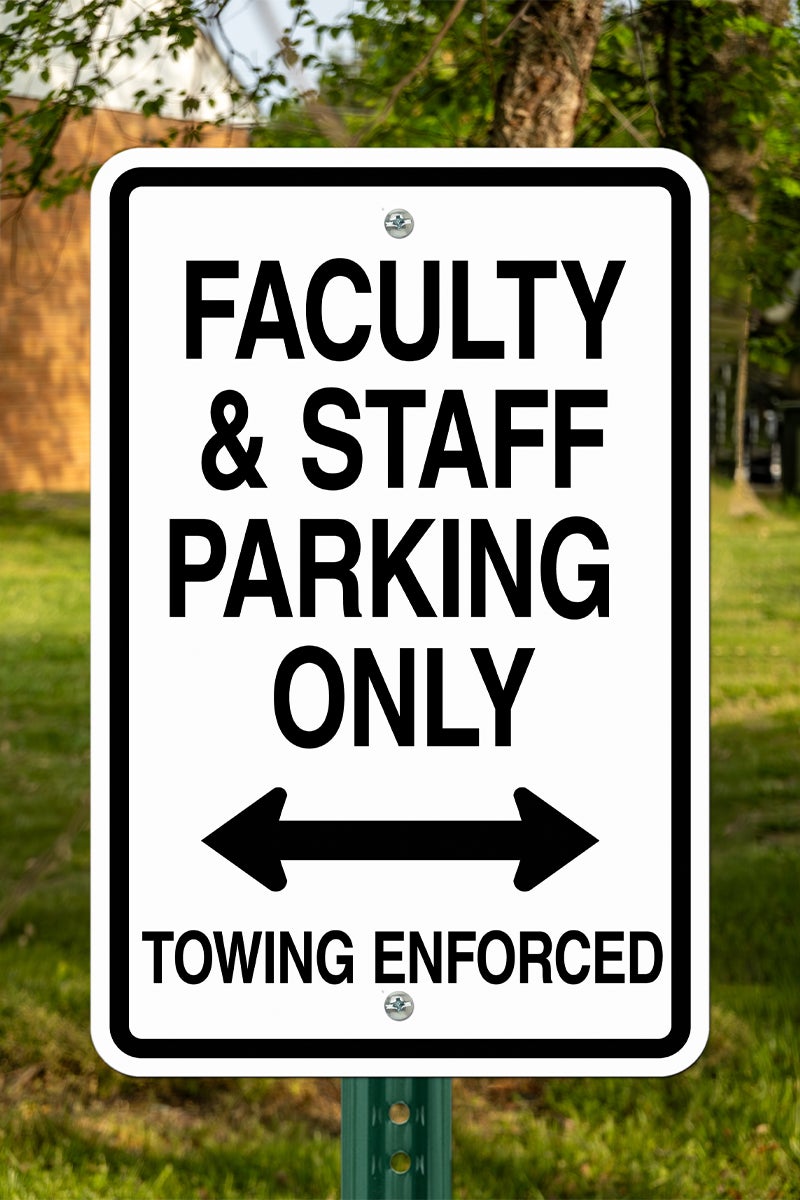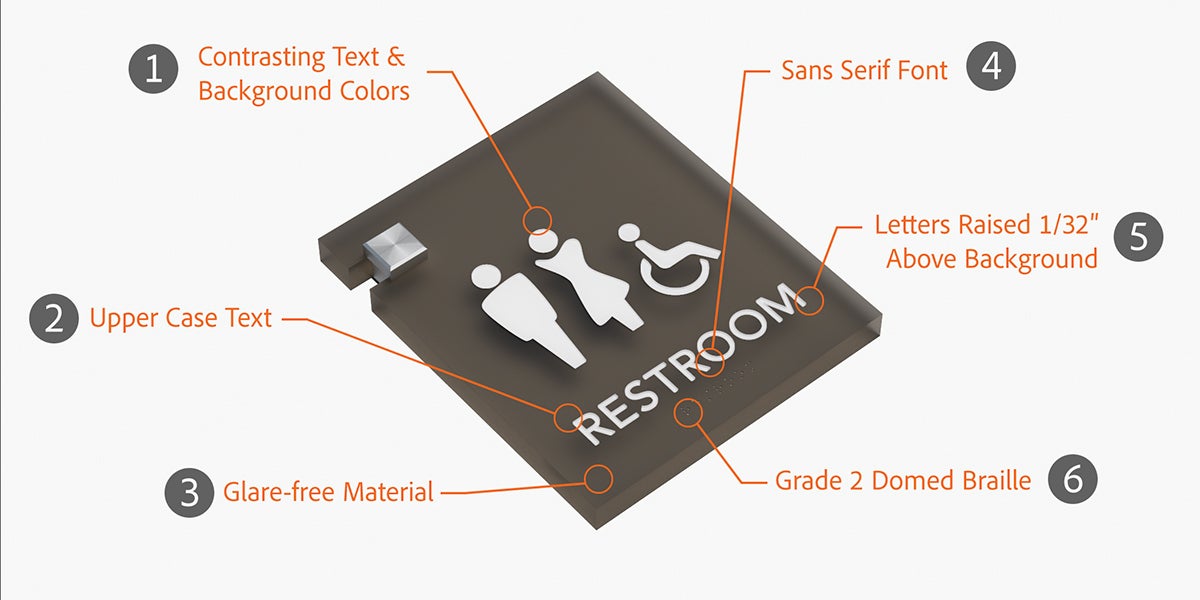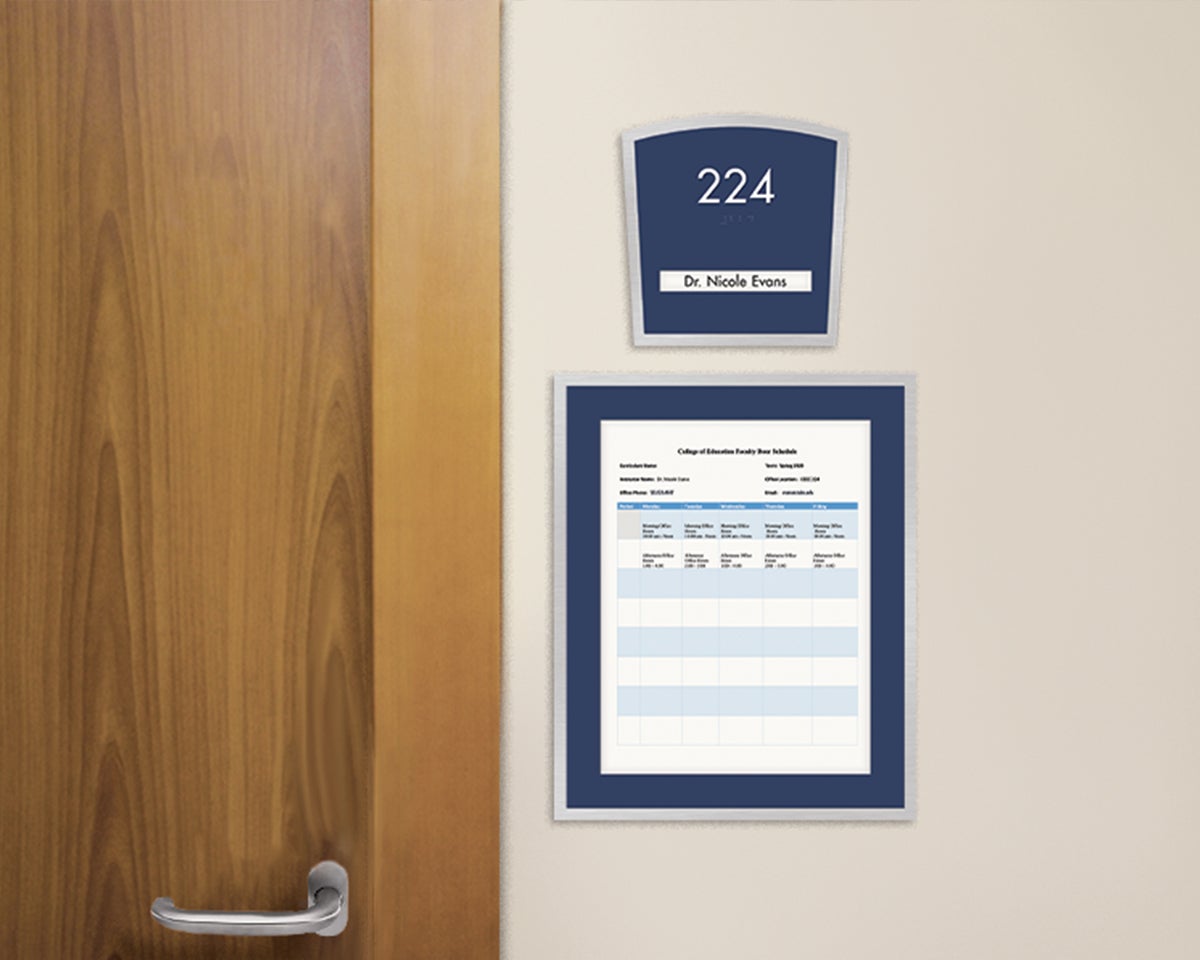University Signage: A Short Guide to Wayfinding, Compliancy, Accessibility, and More!
by Julia Kicinski

No matter the size of your university campus, properly posted signage will ensure that all students, staff, and visitors can safely and effortlessly navigate the area. With so many locations to cover, considering your signage needs may (understandably) feel a little daunting. If you're not sure where to start—or even what signs are required—we've got you covered! Read on for a quick and easy guide to university signage.
The Essentials of Campus Wayfinding Signage

Navigating a new area always comes with a certain level of stress about finding the right building, arriving on time, and generally trying not to get lost. On large college campuses, this concern can even be true of people who have lived or worked there for years and just never ventured to locations outside their routine. You can see how important wayfinding signage—indoors and outdoors—quickly becomes to anybody stepping foot on campus.
What wayfinding signage is integral for a positive campus experience?
Specific types of wayfinding signage are legally required to ensure equal accessibility for anybody navigating your facilities, but we'll also include recommendations for non-required signs that help improve the overall campus navigational experience. The Americans with Disabilities Act (ADA) requires all rooms in your academic and residential buildings to be properly identified, which gives your campus the opportunity to design custom wayfinding signs that match your school colors! Besides ADA-compliant room number and common room signs (discussed in further detail below), your building wayfinding signage should also include directories and directionals with arrows pointing the way toward specific locations.
If you've ever passed a tour group with their noses buried in campus maps, you know how hard it can be for visitors to locate buildings on an unfamiliar campus. Clear outdoor wayfinding signage will provide a huge relief for anyone feeling lost. Post outdoor directionals along sidewalks and roads to clearly mark the way to the various buildings around campus. To maximize the usefulness of these directions, prominently post building IDs so that it's clear which building is which. You may need to label the buildings on multiple sides to allow for the possibility of somebody approaching from another direction.
What wayfinding signs are essential for dorms?

Providing accessible directions inside campus dorms is just as important as in buildings with public access. Directionals in dorm lobbies will help students navigate the halls, find the resident director, and locate community areas like the TV lounge or kitchen. Room number signs with slots for student names will instantly make new residents feel at home (because who doesn't like personalized decor?) and help them identify which rooms belong to their friends. Perhaps the location of the restroom speaks for itself, but make sure to still post appropriate signage on the wall outside each restroom. Remember, you can always customize dorm restroom signs to include more detailed labels like showers or toilets if these areas are separated. Keep up on what's trending with student housing and make sure to label amenities like laundry rooms and new community areas as they're added to the dorms.
ADA-Compliant Dorm Room Number Sign

Believe it or not, there are certain rules put forth by the ADA to ensure that room number signs—including dorm signs—are accessible to everybody including wheelchair users, people with impaired vision, or others with permanent disabilities. One of the most important requirements is using raised characters and Braille on signs. Room number signs also can't just be installed anywhere you deem fit, even for creative design purposes in dorm halls. But don't worry, we'll lay out the requirements below.
Door signs being used to designate a space must follow the ADA guidelines for Raised Character signs.
- Tactile Text, 0.625" - 2" in Height
- ADA-Compliant Sans Serif Font
- Uppercase Characters
- Domed or Rounded Grade 2 Braille Below the Text
- Installed on the Latch Side of the Door
- 48" - 60" Off the Finished Floor
For more information about ADA requirements, read our explanatory page on ADA guidelines.
Do ADA requirements apply to other types of signs? The short answer: Yes.
The long answer: Be it a dorm room, faculty office, student lounge, recital hall, or auditorium, any permanent room on your university campus is going to need an ADA-compliant door or room number sign. The biggest difference between common room signs and room number signs is that your common room signs will probably include additional text and might have more variation in size. However, the basic ADA requirements remain the same regarding mounting specifications and text compliancy standards.
Will it matter if one room isn't labeled?
Well, it technically won't matter if one room is missing the proper identification until somebody is actually looking for it. (Yes, we're joking; of course it matters!) At first glance, it might seem like unfrequented areas like private conference rooms, maintenance rooms, or singular office spaces don't have much of a need for formal wayfinding signs, especially if they have other identifiers like a small nameplate on the door. However, besides being required by law, common room signs and room number signs help visitors know where not to go just as much as where to go. After all, you don't want somebody accidentally walking in on an important meeting or getting disoriented in a janitorial hallway because they figured the unlabeled room must be the one they couldn't find!
Required Regulatory Signage
Contrary to popular belief, rules aren't actually made to be broken. On university campuses, regulatory signage helps enforce rules to ensure the safety and accessibility of students and other campus guests. Regulatory signs encompass a large spectrum of required signage, including but not limited to restroom and wayfinding signs, traffic control signs, and all types of emergency signage.
How much traffic control signage does a university campus really need?

The clearer you are with traffic control signage, the less likely it is that incidents will occur due to confusion in driving and parking areas. Make sure you post basic regulatory signs like Exit, Do Not Enter, Yield, and Stop signs in all appropriate areas around your campus to help keep traffic moving smoothly. Also, put up clear parking signs to indicate who can park where; trust us, painting the pavement won't be good enough! If your campus has parking availability separated by permit type, post signs that clearly indicate the difference between lots. No Parking signs will keep fire zones and loading/unloading areas open, and Reserved Parking signs save parking spots for drivers with specific needs like handicap accessible spaces or electric vehicle charging stations. You also want to indicate if any spaces are reserved for university staff like resident directors, faculty, and cafeteria workers. Additionally, crosswalk signs highlight where pedestrians have the right of way. Making all of these preparations for your parking lots and roads will reduce frustration and help keep drivers and pedestrians safe.
What emergency signage is required across campus?
To be prepared for any emergency situations that may arise, there are certain types of emergency signage that your university is legally obligated to post (and, besides, it just makes good sense!). Emergency signage is particularly important inside buildings so that occupants can tell at a moment's glance where the closest exit is located and determine the best course of action for the situation. Post prominent Stairs and Exit signs in all buildings, including dorms, and indicate floor levels with their corresponding floor IDs. Evacuation maps work with glow-in-the-dark NFPA exit directional signage to guide people out of buildings, even in limited lighting. Other required safety and emergency signage include "In Case of Fire" and "In Fire Emergency" signs that remind people to use the stairs rather than the elevators in fire emergencies. Be sure to also post signs directing the way to the nearest Area of Refuge; this is particularly important on upper floors in dorms and academic buildings alike where there may be people with disabilities that prevent them from using the stairs.
What other regulatory signs are needed?
In addition to the signs already mentioned, there is a variety of regulatory sings you'll want to post across campus to convey property rules and promote accessibility, good hygiene, and general health and wellness in your facilities. For example, restroom signs, with their ADA-compliant raised text, braille lettering, and clear pictograms, inform people which restrooms are male, female, or all-gender, and also which are handicap accessible. Wash hands signs posted inside restrooms and in and around food preparatory areas like the cafeteria, coffee shop, or food court remind employees and patrons to practice good hygiene for the best health.
Features of a Quality Regulatory Restroom Sign

Like all room signs, restroom signs must follow ADA guidelines for text, Braille, spacing, and placement regulations. However, restroom signs typically have the addition of a pictogram that indicates who the restroom is intended for—men, women, or all-gender—which has its own set of requirements for how it must be displayed. Additionally, any restroom on your campus (including in the dorms!) that is handicap accessible must be marked with an ISA symbol to indicate as much.
- Understandable pictogram in 6" space
- ISA symbol if it's handicap accessible*
- Full ADA compliance, including properly contrasting colors
*Check the ISA symbol requirements in your state/locality. Some locations like the states of New York and Connecticut require a dynamic rather than a standard ISA symbol. If you're not sure which you need for your campus, ask our experts at MultiHousingSigns.com!
Informational Signs for College Campuses
Have information you want to share about property rules, upcoming events, building availability, or just helpful tips that aren't necessarily covered under required signage? It's a great idea to post signs containing any information you think people on campus will need to know. Besides being more convenient to visitors and new students learning the system, you'll save your staff the headache of answering the same questions over and over about what time the library closes or who to contact when the campus printers stop working.
Which buildings should have informational signs?
Trick question! All of your buildings should have informational signage! The kind of information displayed for each building will just vary depending on what its purpose is. Dorms, for instance, might have activities and events signs posted with easily updated announcement display boards, but a recreational facility will likely have more permanent signage that answers frequently asked questions such as where to return towels or sign in. You may need to post signs in more than one building notifying visitors about rules or policies such as smoke-free zones, building hours, or areas under surveillance. Consider what information visitors will need to know about each building and add corresponding signage accordingly.
Do recreational facilities need specific kinds of signs?
Due to the nature of the activities they offer, recreational facilities have specific safety and instructional signs to post that aren't necessarily required in other areas on campus. Your campus fitness center should have warning signs, rules and instructions for appropriate use of equipment, and reminders to wipe down and sanitize equipment after each use. If your campus has a pool, check your state's pool signage requirements and post safety and policy signs like Pool Rules, No Diving, and Maximum Capacity.** Of course, you'll also want to post information about the facility's open hours, fitness programs, and other extracurricular activities. Although the latter signs aren't required, they'll make students aware of the variety of amenities and activities available to them at your facility.
**See MultiHousingSign.com's State Safety Regulation Signs page for assistance in determining what pool signage is required for your state.
What other non-required signs would be helpful to add around campus?

If you've already posted signage directing to faculty and staff offices, you're on top of the game. Try adding formal nameplates to these spaces, either on the physical doors or propped up on personal desks. Although not required by law, nameplates can be a great way to help students locate an advisor's office, personalize the space for each staff member, and avoid those awkward moments when visitors blank on the name of their tour guide. Strategically placed A-Frame Signs can also be a great addition to your campus to display menus for any small coffee or snack shops around campus or to call attention to special events tables.
Reach out to a friendly customer service artisan today with any additional questions you might have about university signage. We've been in the sign business since 1987, so we know a thing or two about the types of signs your campus needs to thrive. With numerous customization options and our unmatched product guarantees, you can be confident that you're getting the best campus signs at MultiHousingSigns.com.